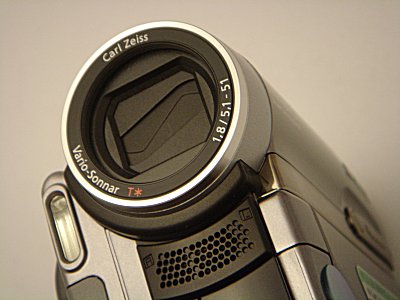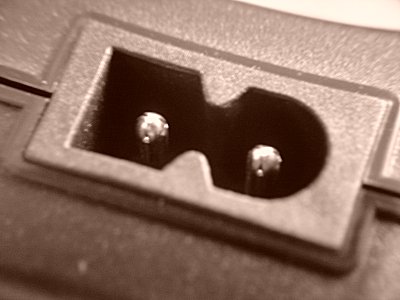Sony DCR-HC90 MiniDV Handycam
The Sony DCR-HC90 MiniDV Handycam is a really small and compact camcorder. It has a 1/3" CCD sensor that performs well in low-light situations. It also has a 3 megapixel digital still picture more that shoots excellent photos. I bought this camcorder due to these three reasons mentioned.
Cross-References
See my "3 MP Digital Camcorder Photo vs. 3 MP Digital Camera Photo" article elsewhere on this site for a comparison between the still photo created with this digital camcorder and the still photo created with my Canon EOS D30 digital camera. See my "The Road to Sony DCR-HC90 MiniDV Handycam" article for a thorough discussion on why this camcorder is a good low-light performer.
Mini-Review: Lens Cover
The Sony DCR-HC90 MiniDV Handycam has a built-in shutter-like lens cover. When you turn the camcorder on, the lens cover opens immediately. When you switch to playback mode or turn the camcorder off, the shutter automatically closes to protect the lens. For many people, this automated lens protection is a wonderful feature, because they will never loose the lens cap and they will never forget to put the lens cap on the camcorder after they are done.

For me, this wonderful feature is a hindrance. I prefer a manual lens cap to an automated lens protector. I'm used to keeping the lens cap off the camera for long periods of time when it's in use. Sometimes shots are lost because I am fondling to remove the lens cap. Even though the automated lens cover shutters are extremely fast, it can never be as fast as a camcorder with its lens protector already removed. In addition, to clean the lens requires the camcorder to be on, so that the lens cover is open. This requirement could be troublesome to deal with if you need to conserve battery life.
And most bothersome of all is that the lens cover mechanism generates gearing noise when it opens and closes. The sound is very similar to a camera shutter open and close, though longer and louder. This creates a problem when trying to shoot discreetly, an unfortunate trait as the Sony DCR-HC90 MiniDV Handycam is a prime candidate for low-light cinematography.
Design Improvement: Keep the automated lens protection feature, but add a manual switch that can keep the lens cover open. With the lens cover closed, the camcorder should automatically open it when it is turned on. But when the manual switch is active, the lens cover is always open, whether the camcorder is on or off.
Mini-Review: AC Power Supply
The Sony DCR-HC90 comes with the Sony AC-L200 AC adapter. Like much of Sony's electronic device interfaces, it has a special proprietary port on the camcorder so that you can't plug any other AC adapter into the camcorder. Whenever you plug the AC-L200 into the camcorder, the camcorder switches to AC power. Unfortunately, the camcorder does not detect whether the AC-L200 is plugged into an AC source first. This means that if the AC-L200 is not plugged into the AC outlet while you plug it into the camcorder, the DCR-HC90 will turn off. So be careful if you are in the middle of a recording session when you plug in the AC-L200 adapter.
To plug the AC-L200 power adapter into the AC outlet, a special AC cable is supplied with the DCR-HC90. At one end of this cable is a regular AC plug. At the other end is a plug that goes into the AC-L200 receptacle (see photo below).

Although the receptacle is specially designed to only allow you to insert the specialized AC cable in one way, I found that the AC-L200 receptacle is not polarized. Today, I couldn't find the special AC cable that is provided with the AC-L200. Instead I had a non-polarized universal AC cable lying around. This universal cable has a non-polarized plug (see photo below). I plugged it into the AC-L200 power supply and the camcorder still worked. I flipped the plug 180 degrees and plugged it, the camcorder worked again. So I am glad to see that although Sony designed a uni-polar receptacle into the AC-L200, it is a non-polarized switching power supply.
Related Links
- dvspot review: Sony DCR-HC90
- Size Matters
- Sony DCR-HC90
- Sony DCR-HC90 First Impressions Camcorder Review
- Sony DCR-HC90 MiniDV Handycam Camcorder w/10x Optical Zoom - Amazon User Reviews
- Sony DCR-HC90E, Panasonic NV-GS250GC, JVC GR-DZ7 (English)
- Sony DCR-HC90 Camcorder Review
- Sony NP-FA50 Rechargeable Battery Pack for DCRPC55 and DCRHC90 - Amazon User Reviews
- Sony NP-FA70 InfoLithium A Series Rechargeable Battery Pack for DCR-HC90, DCR-DVD7 & DCR-PC1000 Camcorders - Amazon User Reviews
- Sony Support and Registration
- SonyStyle
- Super HAD CCD
140 Users Online
|
$10000-above $5000-$9999 $2000-$4999 $1000-$1999 $500-$999 $200-$499 $100-$199 $50-$99 $25-$49 $0-$24 Gift Certificate |
|


